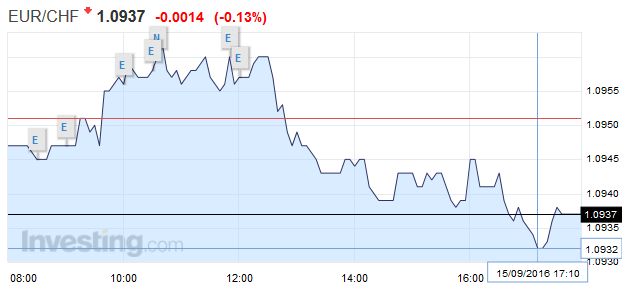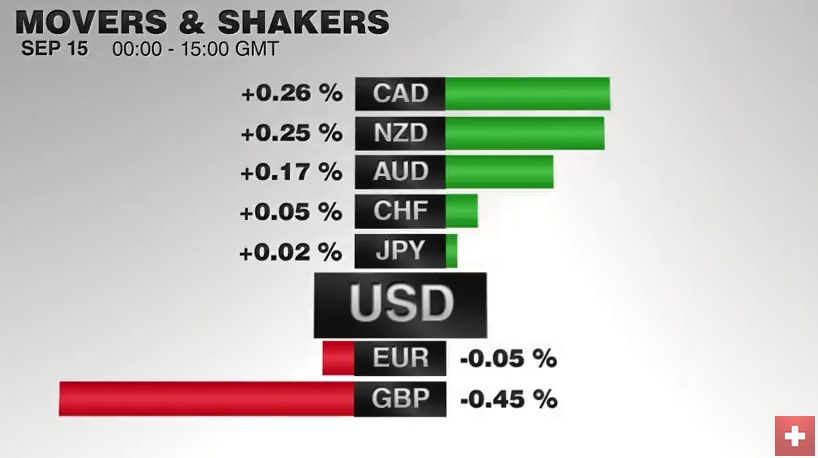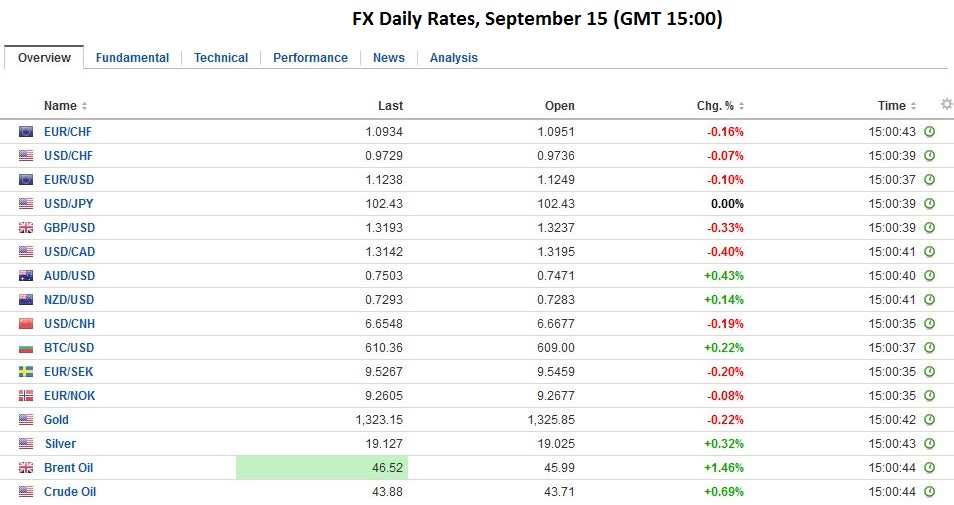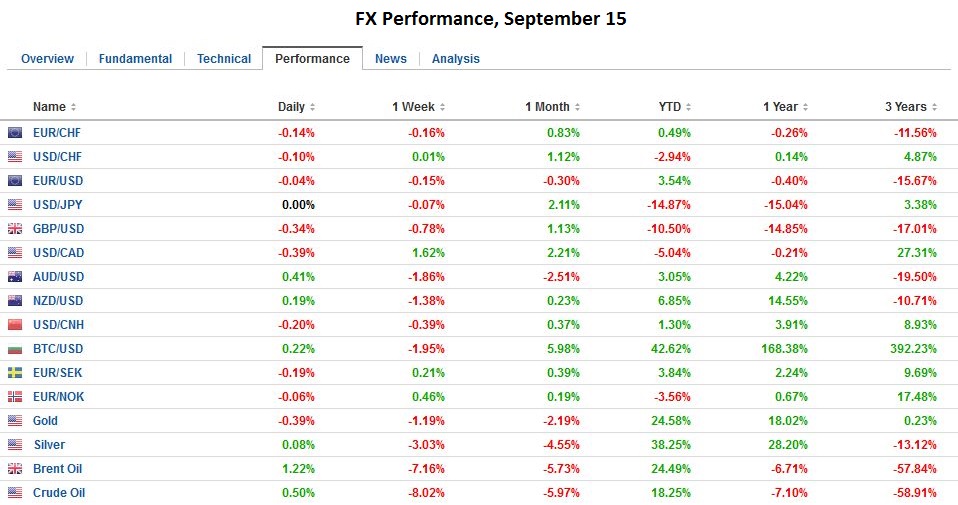Swiss Franc As happened very often, traders expected more the SNB monetary assessment. And, as usually, the franc finally appreciated because the SNB did not act. Click to enlarge. FX Rates Looking at the diary, today is the most important day of the week. The Bank of England and the Swiss National Bank meet. The UK reports retail sales. EMU reports CPI figures. The US reports retail sales, industrial output, and two September Fed surveys. Yet the economic updates are unlikely change sentiment ahead of next week FOMC and BOJ meetings. The euro has been confined to a .1200-.1285 range since the end of last week. It is in the middle of the that range as the European session gets underway. The dollar peaked yesterday near JPY103.35 and is a big figure lower. It been capped near JPY102.50 in Asia. Support is seen near JPY101.80. Sterling is flat, though Asia initially took it through yesterday’s high before peaking near .3280. Technically, there appears to be potential toward .3300-.3330. The dollar-bloc is little changed, with the US dollar trading near seven-week highs against the Canadian and Australian dollars. Movers and Shakers, September 15 MSCI Asia-Pacific was off about 0.3% in late dealings.
Topics:
Marc Chandler considers the following as important: AUD, CAD, EUR, Featured, FX Daily, FX Trends, GBP, Japanese Yen, newsletter, USD
This could be interesting, too:
RIA Team writes The Importance of Emergency Funds in Retirement Planning
Nachrichten Ticker - www.finanzen.ch writes Gesetzesvorschlag in Arizona: Wird Bitcoin bald zur Staatsreserve?
Nachrichten Ticker - www.finanzen.ch writes So bewegen sich Bitcoin & Co. heute
Nachrichten Ticker - www.finanzen.ch writes Aktueller Marktbericht zu Bitcoin & Co.
Swiss FrancAs happened very often, traders expected more the SNB monetary assessment. And, as usually, the franc finally appreciated because the SNB did not act. |
|
FX RatesLooking at the diary, today is the most important day of the week. The Bank of England and the Swiss National Bank meet. The UK reports retail sales. EMU reports CPI figures. The US reports retail sales, industrial output, and two September Fed surveys. Yet the economic updates are unlikely change sentiment ahead of next week FOMC and BOJ meetings. The euro has been confined to a $1.1200-$1.1285 range since the end of last week. It is in the middle of the that range as the European session gets underway. The dollar peaked yesterday near JPY103.35 and is a big figure lower. It been capped near JPY102.50 in Asia. Support is seen near JPY101.80. Sterling is flat, though Asia initially took it through yesterday’s high before peaking near $1.3280. Technically, there appears to be potential toward $1.3300-$1.3330. The dollar-bloc is little changed, with the US dollar trading near seven-week highs against the Canadian and Australian dollars. |
|
|
MSCI Asia-Pacific was off about 0.3% in late dealings. The loss is minor, but its extends the losing streak to the sixth session, which makes it the longest suck streak since May. Asian bond yields were mostly softer, though Australia bucked the trend as its 10-year bond yield was slightly firmer. European bond yields are also beginning the day 1-2 bp firmer. US 10-year Treasury is straddling the 1.70% level.
Australia reported that it lost 3.9k jobs in August. The market expected a 15k increase. However, full-time jobs grew 11.5k. The unexpected decline in the unemployment rate from 5.7% to 5.6% was a function of the unanticipated decline in the participation rate to 64.7 (from 64.9). The participation rate matches the lowest since November 2014. The Australian dollar is flat as it continues to consolidated the large (1.3%) loss on Tuesday. Since then it has been unable to resurface above the previous support near $0.7500. |
|
| The New Zealand dollar is weakest of the majors so far today. It is off 0.2%. Some reports suggest there was disappointment that the economy only expanded 0.9% in Q2 instead of 1.1%. The pace of growth would be the envy of most countries and minor loss hardly requires a unique fundamental explanation.
It appears that the bond and equity markets have entered a new phase that is seeing yields trend higher, and equity prices move lower. The pace of this adjustment may be more important than the economic data per se in driving the foreign exchange market. The dollar-bloc currencies and the Scandis seem most vulnerable among the majors, while the freely accessible emerging market currencies, which mostly have current account deficits, are also under pressure. |
Japan
The BOE has provided low rate loans to banks, cut interest rates, resumed asset purchases (both Gilts and corporate bonds). Most of the economic data in recent weeks has been reported above expectations. There is no compelling reason to expect the BOE to take additional measures now. It will likely keep the door open to additional action when or if needed. Retail sales may pullback after the heady 1.4% gain in July. If there is a risk with the retail sales, we suspect it would be on the upside due to strong tourism, given sterling’s depreciation post-referendum.
United StatesAfter a quiet few days in terms of US economic report, a full slate of data will be released today. The most important is retail sales, which account for about 40% of US personal consumption expenditures. Softer auto sales and lower gasoline prices will weigh on the headline, but the GDP components, which also exclude building materials, is expected to show a 0.4% increase. It true, it would match this year’s average, which is almost twice last year’s.
|
U.S. Current Account(see more posts on U.S. Current Account, )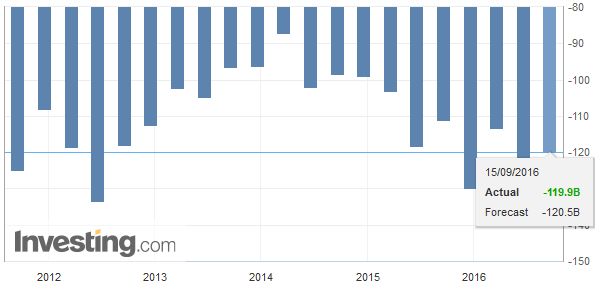 Click to enlarge. Source Investing.com |
U.S. NY Empire State Manufacturing IndexThe US also reports producer prices (0.1% gain is expected on the headline month-over-month and year-over-year), which is not a market mover. Nor will industrial output and manufacturing production figures for August draw much attention. |
U.S. NY Empire State Manufacturing Index(see more posts on U.S. NY Empire State Manufacturing Index, )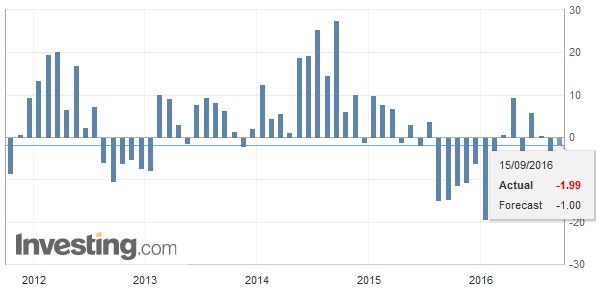 Click to enlarge. Source Investing.com |
U.S. Philadelphia Fed Manufacturing IndexThe risk is that after strong gains in July a modest pullback was experienced last month. Two Fed surveys (Empire and Philadelphia) cover the month of September. These reports pose some headline risk, but there are both reported at the same time as retail sales (and Q2 current account balance) and may be lost in the shuffle. |
U.S. Philadelphia Fed Manufacturing Index(see more posts on U.S. Philadelphia Fed Manufacturing Index, )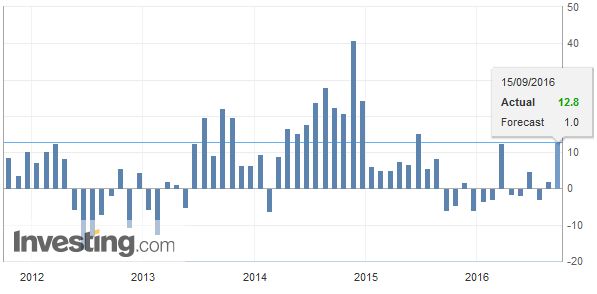 Click to enlarge. Source Investing.com |
Graphs and additional information on Swiss Franc by the snbchf team.

